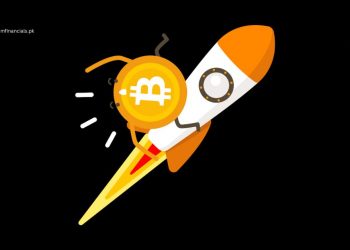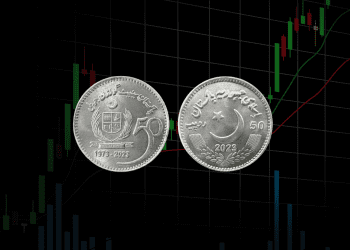After a week of cautious optimism and calculated risk-taking, Pakistan’s financial scene delivered a range of results in different areas. A succession of notable economic movements kept everyone alert, from the glittering jewels of the bullion market to the busy trade floors of the Karachi Stock Exchange. This piece offers a comprehensive summary of the week’s significant changes in the currency exchange rate, gold investments’ dazzling appeal, and stock market fluctuations, emphasising the ramifications for both experienced and inexperienced investors.
THE STOCK MARKET: A STUDY IN RESILIENCE
A Closer Look at KSE-100’s Performance: The KSE-100 Index, a barometer for Pakistan’s stock market health, exhibited a modest increase, marking a close at 65,793.76. This upward nudge, though slight, speaks volumes of the market’s resilience amidst anticipatory vibes surrounding the upcoming monetary policy meeting.
Trading Volume and Sectoral Movements: The average daily trading volume showed a palpable heartbeat within the market, with numbers slightly up from the previous week.
Noteworthy is the sectorial performance where Oil & Gas Exploration Companies took the lead, followed by gains in Investment Banks and Securities Companies, showcasing a selective yet optimistic market sentiment.
GOLD: THE RADIANT HAVEN
Unprecedented Surge: The domestic bullion market was ablaze with activity, as gold prices soared to remarkable highs. The 24-karat gold leaped nearly Rs10,000 per tola, anchoring at an unprecedented price level. This surge is mirrored in the international arena, with spot gold peaking at record highs, driven by a global anticipation of a dovish turn in monetary policies.
Global Cues and Domestic Impact: The rally was fueled by a series of dovish signals from major economies, notably the U.S., where manufacturing and labor market data alongside Federal Reserve’s hints at easing, primed the market for gold’s ascent. This bullish momentum in gold is a testament to its enduring appeal as a refuge amid economic uncertainties.
THE CURRENCY TAPESTRY
PKR’s Steady Stride: In the realm of currencies, the Pakistani Rupee (PKR) showcased a tempered strength, gaining marginally against the USD. This stability, though subtle, is a crucial factor in the broader economic narrative, influencing import costs and the pricing dynamics in the domestic gold market.
This week, the Pakistani Rupee (PKR) has exhibited remarkable resilience, rising by almost 16 paisa versus the US dollar (USD). It ended the week at a respectable PKR 279.04 to the USD, up from PKR 279.18 at the close of the previous week. The native currency demonstrated its resilience in the financial markets throughout the trading day, strengthening by almost 25 paisa, hitting an intraday high of 279.65 and a low of 279.4.
Interplay of Economic Indicators: Beyond the currency’s performance, a spectrum of economic indicators, from inflation rates to external debt figures, offers a comprehensive view of the nation’s economic pulse. The CPI, trade balance, and foreign investment flows, among others, stitch together a narrative of challenges and opportunities that lie on the horizon.
UNDERSTANDING PAKISTAN’S MARKET DYNAMICS
We examine Pakistan’s economic performance over the last week in detail in our most recent economic digest. This extensive research includes a wide range of data, such as gold prices and wider economic measurements, as well as currency valuations and stock market changes. By emphasising developments and trends that may have an impact on investment choices and economic forecasts, we hope to provide our readers with an insight of the state of the financial system today. This update offers crucial insights into significant financial moves and their possible ramifications, whether you’re an investor, economist, or just someone curious about Pakistan’s economic situation.
Indicator Mar 08, 2024 Mar 01, 2024 PKR InterBank 279.0366 279.1932 KSE100 Index 65,793.76 65,325.69 Avg Daily Volume 425,011,077 418,498,717 Gold (Karachi) Rs/10 gm 195,988 185,871 KIBOR 6M 21.36 21.73 10Y PIB 14.22 14.33 EUR 1.0939 1.084 GBP 1.2859 1.2653 CHF 0.8777 0.8834 JPY 147.072 150.116 CNY 7.1861 7.1967 GOLD 2,178.78 2,083.32 SILVER 24.312 23.139 USD (Open Market) 281.70 282.03 EUR (Open Market) 306.99 303.59 GBP (Open Market) 359.25 354.66 JPY (Open Market) 1.89 1.86 AED (Open Market) 76.57 76.69 SAR (Open Market) 74.80 74.90 T-Bill Auction 3M 21.4002 21.6998 T-Bill Auction 6M 20.3949 20.3952 T-Bill Auction 12M 20.2998 20.3290 PIB Auction 3Y 16.7999 16.8000 PIB Auction 5Y 15.5499 15.5000 PIB Auction 10Y 14.5000 14.5000 SBP Policy Rate 22.00 21.00 SBP Reverse Repo Rate 23.00 22.00 SBP Repo Rate 21.00 20.00 SBP FX Reserves 7,895.70 7,949.60 Bank FX Reserves 5,124.30 5,088.90 Total FX Reserves 13,020.00 13,038.50 SPI (Combined Group) 322.86 319.30 CPI (MOM %) 0.03 1.83 CPI (YOY %) 23.06 28.34 WPI (MOM %) 1.12 1.47 WPI (YOY %) 18.66 26.95 Sensitive Price Indicator (MOM %) -0.13 1.98 Sensitive Price Indicator (YOY %) 36.26 43.86 Exports 2,573.00 2,792.00 Imports 4,285.00 4,771.00 Trade Balance -1,712.00 -1,979.00 Home Remittances 2,249.77 2,397.91 Total Foreign Investment -147.71 243.33 Current Account Balance -269.00 404.00 REER Index 101.7026 98.8267 Large Scale Manufacturing Index 132.87 114.85 Pakistan’s External Debt 131,159.10 129,742.00 GDP Growth Rate -0.17 6.17 Agriculture Growth Rate 2.25 4.28 Manufacturing Growth Rate -5.29 10.86 Commodity Sector Growth Rate -0.50 5.49 Services Sector Growth Rate 0.07 6.66 Budget Deficit (% of GDP) -7.70 -7.90 Total Debt & Liabilities (% of GDP) 91.10 89.70 Total Debt & Liabilities (Rs. Billion) 77,104.10 59,772.10 Trade Balance (July – June) -27,547.00 -48,354.00 Worker Remittances (July – June) 27,027.63 31,278.80 Foreign Investment (July – June) 429.67 1,857.84 Current Account Balance (July – June) -2,387.00 -17,481.00 Annual Inflation Rate % (July – June) 29.18 12.15
CONCLUSION
This past week’s economic odyssey through Pakistan’s markets has unveiled a multifaceted landscape of opportunities and cautionary tales.
The incremental yet resilient stock market growth, the buoyant rally in gold prices, and the nuanced stability of the PKR against the backdrop of broader economic indicators, collectively sketch a roadmap for navigating the intricate terrain of financial investments.
As we parse through these insights, the narrative woven offers not just a reflection of the present but a glimpse into the strategic moves that could shape the future of Pakistan’s economic journey.

















